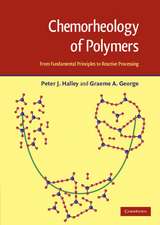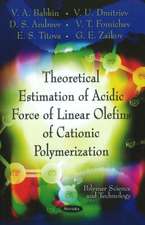Drying of Polymeric and Solid Materials: Modelling and Industrial Applications
Autor Jean-Maurice Vergnauden Limba Engleză Paperback – 20 noi 2011
Preț: 394.71 lei
Nou
Puncte Express: 592
Preț estimativ în valută:
75.55€ • 82.09$ • 63.50£
75.55€ • 82.09$ • 63.50£
Carte tipărită la comandă
Livrare economică 21 aprilie-05 mai
Preluare comenzi: 021 569.72.76
Specificații
ISBN-13: 9781447119562
ISBN-10: 1447119568
Pagini: 360
Ilustrații: XX, 336 p.
Dimensiuni: 170 x 242 x 19 mm
Greutate: 0.57 kg
Ediția:Softcover reprint of the original 1st ed. 1992
Editura: SPRINGER LONDON
Colecția Springer
Locul publicării:London, United Kingdom
ISBN-10: 1447119568
Pagini: 360
Ilustrații: XX, 336 p.
Dimensiuni: 170 x 242 x 19 mm
Greutate: 0.57 kg
Ediția:Softcover reprint of the original 1st ed. 1992
Editura: SPRINGER LONDON
Colecția Springer
Locul publicării:London, United Kingdom
Public țintă
ResearchCuprins
1 Principles and General Equations.- 1.1 Transport of Liquid Through a Solid.- 1.2 Evaporation of Liquid from the Surface.- 1.3 Diffusion of Vapour Outside the Solid.- 1.4 Effect of Parameters.- 1.5 General Equations.- 2 Thin Plane Sheet.- 2.1 Non-steady State with Infinite Rate of Evaporation.- 2.2 Non-steady State with Finite Rate of Evaporation.- 2.3 Membrane Suspended in an Infinite Atmosphere.- 2.4 Conclusions.- Appendixes. Methods of Solution of Fick’s Law When the Diffusivity is Constant.- 2. A Separation of Variables.- 2.B Diffusion-Evaporation From a Plane Sheet of Thickness L, with Infinite Rate of Evaporation.- 2.C Half-Life of Desorption Process.- 2.D Reflection and Superposition.- 2.E Error Function.- 2.F Layer of Diffusing Substance on a Permeable Sheet, with Infinite Rate of Evaporation.- 2.G Membrane with Constant Concentration on Each Surface, and Infinite Rate of Evaporation.- 3 Cylinder.- 3.1 Solid Cylinder of Infinite Length, Non-steady State with Constant Diffusivity.- 3.2 Cylinder of Finite Length, Non-steady State.- 3.3 Liquid-Filled Hollow Cylinder of Infinite Length, Steady State.- 3.4 Conclusions.- Appendix. Radial Diffusion in a Solid Cylinder of Infinite Length with Infinite Rate of Evaporation.- 4 Sphere.- 4.1 Solid Sphere, Non-steady State with Infinite Rate of Evaporation.- 4.2 Solid Sphere, Non-steady State with Finite Rate of Evaporation.- 4.3 Liquid-Filled Hollow Sphere.- 4.4 Conclusions.- 5 Numerical Analysis for a Plane Sheet.- 5.1 Infinite Rate of Evaporation.- 5.2 Finite Rate of Evaporation.- 5.3 Conclusions.- 6 Numerical Analysis for a Cylinder.- 6.1 Solid Cylinder of Infinite Length with Infinite Rate of Evaporation.- 6.2 Solid Cylinder of Infinite Length with Finite Rate of Evaporation.- 6.3 Solid Cylinder of Finite Length withInfinite Rate of Evaporation.- 6.4 Solid Cylinder of Finite Length with Finite Rate of Evaporation.- 6.5 Liquid-Filled Hollow Cylinder of Infinite Length with Infinite Rate of Evaporation.- 6.6 Liquid-Filled Hollow Cylinder of Infinite Length with Finite Rate of Evaporation.- 6.7 Liquid-Filled Hollow Cylinder of Finite Length with Infinite Rate of Evaporation.- 6.8 Liquid-Filled Hollow Cylinder of Finite Length with Finite Rate of Evaporation.- 6.9 Conclusions.- 7 Numerical Analysis for a Sphere.- 7.1 Solid Sphere with Infinite Rate of Evaporation.- 7.2 Solid Sphere with Finite Rate of Evaporation.- 7.3 Liquid-Filled Hollow Sphere with Infinite Rate of Evaporation.- 7.4 Liquid-Filled Hollow Sphere with Finite Rate of Evaporation.- 7.5 Conclusions.- 8 Diffusion-Evaporation in Two and Three Dimensions: Isotropic and Anisotropic Media.- 8.1 Introduction.- 8.2 Two Dimensions with Infinite Rate of Evaporation.- 8.3 Two Dimensions with Finite Rate of Evaporation.- 8.4 Three Dimensions with Infinite Rate of Evaporation.- 8.5 Three Dimensions with Finite Rate of Evaporation.- 8.6 Conclusions ..- 9 Drying of Paints.- 9.1 Introduction.- 9.2 One Layer.- 9.3 Two Layers.- 9.4 Conclusions.- 10 Drying of Wet Earth for Adobe Construction.- 10.1 Introduction.- 10.2 Modelling the Drying of Wet Earth.- 10.3 Conclusions.- 11 Drying of Rubbers.- 11.1 Introduction.- 11.2 Thin Sheets.- 11.3 Cylinders of Finite Length.- 11.4 Tubes of Infinite Length.- 11.5 Annuli.- 11.6 Conclusions of the Drying of Rubbers.- 12 Drying of Plasticised PVC.- 12.1 Introduction.- 12.2 Drying Process.- 12.3 Conclusions.- 13 Drying of Wood.- 13.1 Introduction.- 13.2 Thin Sheets.- 13.3 Diffusion-Evaporation in Two Dimensions.- 13.4 Diffusion-Evaporation in Three Dimensions.- Symbols.- 14 Drying of Thermosetting Coatings.- 14.1 Introduction.- 14.2 Drying Process.- 14.3 Conclusions.- 15 Drying of Dosage Forms for Medical Applications.- 15.1 Introduction.- 15.2 Drying in an Infinite Atmosphere.- 15.3 Drying in an Finite Atmosphere.- 15.4 Drying Under Controlled Vapour Pressure.- 15.5 Conclusions.- 16 Drying of a Polymer Sphere with Shrinkage.- 16.1 Introduction.- 16.2 Theory.- 16.3 Experiment.- 16.4 Results.- 16.5 Conclusions.- Symbols.











